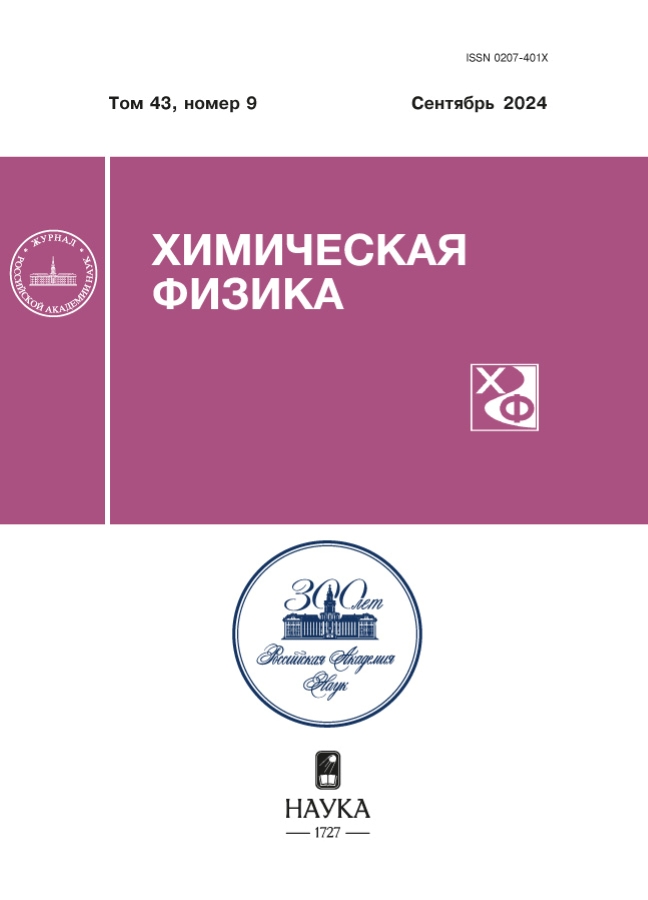Oxidation of the Styrene Epoxide – Hydroquinone – Copper(II) Chloride Ternary System in a Methanol Solution
- 作者: Petrov L.V.1, Solyanikov V.M.1
-
隶属关系:
- Federal Research Center for Problems of Chemical Physics and Medical Chemistry of the Russian Academy of Sciences
- 期: 卷 43, 编号 9 (2024)
- 页面: 53-60
- 栏目: Kinetics and mechanism of chemical reactions, catalysis
- URL: https://cardiosomatics.orscience.ru/0207-401X/article/view/680966
- DOI: https://doi.org/10.31857/S0207401X24090062
- ID: 680966
如何引用文章
详细
The consumption of styrene epoxide (SE) and hydroquinone (HQ) in a ternary TrS system (SE – HQ – Cu(II)) in an oxygen atmosphere in a methanol solution was studied. Oxygen uptake by the triple system SE – HQ – CuCl2 was studied manometrically. Expression of velocity in terms of reagent concentrations V = k [Cu(II)]1 [HQ]0 [SE]0, the effective oxidation rate constant k = 1.82×105 exp(– 40 kJ mol-1/RT) s-1, (308–323) K. The mechanism of oxidation of TrS is discussed.
全文:
作者简介
L. Petrov
Federal Research Center for Problems of Chemical Physics and Medical Chemistry of the Russian Academy of Sciences
编辑信件的主要联系方式.
Email: plv@acp.ac.ru
俄罗斯联邦, Chernogolovka
V. Solyanikov
Federal Research Center for Problems of Chemical Physics and Medical Chemistry of the Russian Academy of Sciences
Email: plv@acp.ac.ru
俄罗斯联邦, Chernogolovka
参考
- Ch. Schneider, Synthesis 23, 3919 (2006). https://doi.org/ 10.1055/s-2006-950348
- G. Sabitha, R. Satheesh Babu, M. Rajkumar, Ch. Srinivas Reddy, J.S. Yadav, Tetrahedron Lett. 42, 3955 (2001). https://doi.org/10.1016/S0040-4039(01)00622-0
- Y.-X. Zhou, Y.-Z. Chen, Y. Hu, G. Huang, S.-H. Yu, H.-L. Jiang, Chem. Eur. J. 20, 1 (2014). https://doi.org/ 10.1002/chem. 201404104
- Y. Zhang, M. Wang, P. Li, L. Wang, Org. Lett. 14, 2206 (2012). https://doi.org/10.1021/o1300391t
- D.A. Denisov, R.A. Novikov, Y.V. Tomilov, Russ. Chem. Bull. 70, 1568 (2021). https://doi.org/10.1007/S11172-021-3253-9
- R.E. Parker, N.S. Isaacs, Chem. Rev. 53, 737 (1959). https://doi.org/10.1021/cr50028a006
- A.M. Ross, T.M. Pohl, K. Piazza, M. Thomas, B. Fox, D.L. Whalen, J. Am. Chem. Soc. 104, 1658 (1982). https://doi.org/10.1021/ja00370a035
- A. Lundin, I. Panas, E. Ahlberg, J. Phys. Chem. A 111, 9087 (2007). https://doi.org/10.1021/jp073285b
- P.O. Wennberg, D.G. VanderVelde, N.C. Eddingsaas, J. Phys. Chem. A 114, 8106 (2010). https://doi.org/10.1021/jp103907c
- Z. Huan, Ch. Yung, Z. Ma, E.R. Gainer, D. Li, J. Phys. Chem. A 118, 1557 (2014). https://doi.org/10.1021/jp501310z
- L.V. Petrov, V.M. Solyanikov, Russ. Chem. Bull. 64, 107 (2015).
- L.V. Petrov, V.M. Solyanikov, Russ. J. Phys. Chem. B 10, 764 (2016). https://doi.org/10.1134/S1990793116050225
- L.V. Petrov, V.M. Solyanikov, Pet. Chem. 57, 734 (2017). https://doi.org/10.1134/S0965544117080114
- L.V. Petrov, V.M. Solyanikov, Russ. J. Phys. Chem. B 12, 1003 (2018). https://doi.org/10.1134/S1990793118060179
- L.V. Petrov, V.M. Solyanikov, Russ. Chem. Bull. 69, 1869 (2020). https://doi.org/10.1007/S11172-020-2972-7
- L.V. Petrov, V.M. Solyanikov, Russ. J. Phys. Chem. B 15, 599 (2021). https://doi.org/10.1134/S1990793121040084
- V.A. Menshov, V.D. Kancheva, O.L. Yablonskaya, A.V. Trofimov, Russ. J. Phys. Chem. B 15, 108 (2021). https://doi.org/10.1134/S1990793121010231
- I.F. Rusina, T.L. Veprintsev, R.F. Vasil’ev, Russ. J. Phys. Chem. B 16, 50 (2022). https://doi.org/10.1134/S1990793122010274
- L.V. Petrov, V.M. Solyanikov, Russ. J. Phys. Chem. B 15, 960 (2021). https://doi.org/10.1134/S1990793121060075
- L.V. Petrov, B. L. Psikha, V.M. Solyanikov, Pet. Chem. 49, 263 (2009).
- L.V. Petrov, V.M. Solyanikov, Pet. Chem. 39, 107 (1999).
- L.V. Petrov, V.M. Solyanikov, Russ. J. Phys. Chem. B 17, 1259 (2023). https://doi.org/10.1134/S1990793123060234
补充文件
















